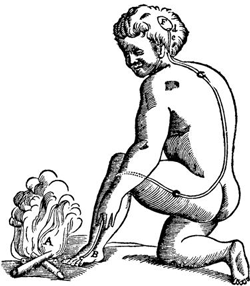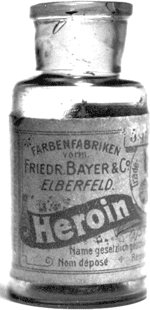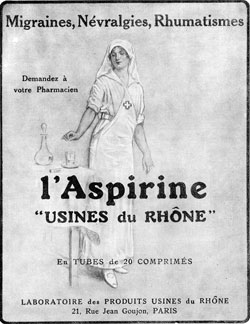Illustration of Pain Pathway by René Descartes

Illustration of the pain pathway in René Descartes’ Traite de l’homme (Treatise of Man), 1664. The long fiber running from the foot to the cavity in the head is pulled by the heat and releases a fluid that makes the muscles contract. Source: Public Domain.
Since ancient times, humans have sought to conquer pain using a variety of treatments ranging from the sublime to the bizarre. Although the Greeks and Romans first advanced a theory of sensation—the idea that the brain and nervous system have a role in producing the perception of pain—it was not until the Middle Ages and well into the Renaissance that evidence began to accumulate in support of these theories.
In 1664 the French philosopher René Descartes described what, to this day, is still called a pain pathway. Descartes illustrated how particles of fire in contact with the foot travel to the brain and compared pain sensation to the ringing of a bell.
In the nineteenth century the application of new chemical and scientific techniques led to the development of morphine, codeine, and heroin—potent pain medications derived from opium. In the early 1800s morphine was marketed as a pain medication as well as treatment for opium and alcohol addiction. During this era, another potent pain medication and appetite suppressant—cocaine—was successfully isolated from coca leaves by a German chemist. In the late 1800s and early 1900s, heroin was marketed by Bayer Pharmaceutical Products as a non-addictive morphine substitute and cough suppressant.


Left: Bayer Heroin bottle, originally containing 5 grams of Heroin substance. Right: A 100-ml bottle of laudanum. Note the dosages on the label for infants, children, and adults. Source for both images: Wikimedia Commons.
Laudanum, a popular tincture containing opium and alcohol and other ingredients such as honey, saffron, or cinnamon, was widely used—and completely legal—until the late 1800s. It was commonly used for pain, menstrual cramps, sleep aid, and a wide variety of other ailments both in children and adults.

Advertisement for curing morphine addictions from Overland Monthly, January 1900.
Although coca leaves, opium, and other narcotics had been used for millennia to treat pain, the isolation of the narcotic compounds within these drugs and their subsequent availability in tablet and powder forms led to their widespread adoption as pain medications, as well as to their widespread abuse.

A 1923 advertisement for aspirin. Source Wikimedia Commons.
Although coca leaves, opium, and other narcotics had been used for millennia to treat pain, the isolation of the narcotic compounds within these drugs and their subsequent availability in tablet and powder forms led to their widespread adoption as pain medications, as well as to their widespread abuse.
At the turn of the nineteenth century, “pure” aspirin was isolated from salicylate-rich plants. This discovery represented a major breakthrough in the history of pain medications. To this day aspirin is the most commonly used pain reliever worldwide.
During the twentieth century many opioid and non-opioid medications continued to be developed. In the 1950s, a drug called Percodan was approved by the Food and Drug Administration. A combination of oxycodone and aspirin, the relative ease with which this powerful opioid medication could be obtained, along with the contention that a narcotic prescribed by a physician could not lead to addiction, exacerbated an ongoing opioid abuse problem that has ebbed and flowed for millennia.
